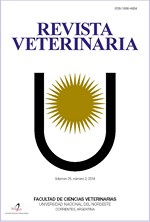Factors that predisposed to canine parvovirosis in a hospital of Cuautitlan, Mexico
DOI:
https://doi.org/10.30972/vet.3114618Keywords:
Dog, parvovirosis, climate, age, sex, feeding, vaccinationAbstract
Canine parvovirus (CPV) was initially described in the Canidae family, but later extended to Ursidae, Procionidae, and Felidae families, among others. Its epidemiology has not been fully described. Nevertheless, climate appears to have a direct influence on the severity of the disease symptomatology. Aim of this study was to analyze the influence of different factors such as age, breed, gender, vaccination status, and climatic variables, by means of analyzing cases of this disease recorded at an veterinary hospital from Cuautitlan (México). For this purpose, clinic histories from 2016 until 2017, were analyzed. Prevalence of 1.86% was determined, being animals under seven months-old those with the highest susceptibility to CPV. In addition, from March to May, the highest number of cases were diagnosed, with peak on April. The environmental temperature explains the higher presentation of cases of parvovirus. Considering these results, it can be concluded that CPV seems to be more frequent during the warmer months, followed by high number of offspring and lower consumption of food.
Downloads
References
Candanosa E, Ducoing A, Ruiz RA, Sánchez F. 2007. Diagnóstico del parvovirus canino-2 (pvc-2) por inmunohistoquímica en perros domésticos. Vet Méx 38: 41-53.
Carman PS, Povey RC. 1984. The seroprevalence of canine parvovirus-2 in a selected sample of the canine population in Ontario. The Canad Vet J 25: 259-262.
Carmichael LE, Schlafer DH, Hashimoto A. 1994. Minute virus of canines (MVC canine parvovirus type-1): pathogenicity for pups and seroprevalence estimate. J Vet Diagn Invest 6: 165-174.
Castro TX et al. 2007. Clinical and epidemiological aspects of canine parvovirus enteritis in the State of Rio de Janeiro. Arq Bras Med Vet Zoot 59: 333-339.
Cotmore S et al. 2014. The family parvoviridae. Archives of virology 159: 1239-1247.
Decaro N, Buonavoglia C. 2012. Canine parvovirus. A review of epidemiological and diagnostic aspects, with emphasis on type 2c. Vet Microbiol 155: 1-12.
Ernst S, Montes S, Huber A. 1987. Prevalencia de parvovirosis clínica en una población canina hospitalaria de Valdivia, Chile. Av Cs Vet 2: 99-104.
Ettinger S, Feldman E. 2009. Textbook of veterinary internal medicine, Elsevier Health Sciences, 7º ed., Saunders, Philadelphia.
Houston DM, Ribble CS, Head LL. 1996. Risk factors associated with parvovirus enteritis in dogs: 283 cases (1982-1991). J Am Vet Med Assoc 208: 542-546.
Martin R. 1978. Población canina y felina en Chile. Serie Scientia et Tecnica Nº 1-1978, Universidad Austral de Chile, Valdivia.
Miranda C, Thompson G. 2016. Canine parvovirus in vaccinated dogs: a field study. Vet Rec 16: 397-402.
Morales MA, Mora L, Salazar J. 1997. Distemper canino: sobrevida por edad, sexo, raza y estación. Avan Cienc Vet 12: 41-44.
Pardo M. 2016. Frecuencia de huevos de nematodos gastrointestinales en heces de perros en el Parque Central Simón Bolívar de Bogotá. Tesis p. título de Méd. Vet. en Univ.La Salle, Colombia. http://repository.lasalle.edu.co/handle/10185/17543.
Ramsey I, Tennant B. 2012. Manual de enfermedades infecciosas en pequeños animales, Editorial Lexus, Barcelona, p. 381.
Ruiz A, Cardona E, Ducang A. 2007. Diagnóstico del parvovirus canino por inmunohistoquímica en perros domésticos. Rev Vet Méx 38: 01.
Sosa KA. 2009. Estudio de la diversidad del parvovirus canino tipo 2 (CPV-2). Nº. 578.822-SOS. https://core.ac.uk/download/pdf/54219842.pdf
Tamimi N. 2017. Prevalence of diseases in the canine referred to a private practice in Baghdad in 2015-2016. Kufa J Vet Med Sci 8: 16-23.
Vera V. 2012. Análisis espacio-temporal de casos de síndrome de gastroenteritis hemorrágica en caninos, según fichas médicas de una clínica veterinaria de la comuna de Conchalí, período 2000-2008. Tesis para optar al título Médico Veterinario, Escuela de Ciencias Veterinarias, Universidad de Chile, 58 p.
Downloads
Published
How to Cite
Issue
Section
License
Copyright (c) 2020 F. A. Aponte, R. V. Gómez, Y. M. Lopez

This work is licensed under a Creative Commons Attribution-NonCommercial 4.0 International License.
Revista Veterinaria (Rev. Vet.) maintains a commitment to the policies of Open Access to scientific information, as it considers that both scientific publications as well as research investigations funded by public resources should circulate freely without restrictions. Revista Veterinaria (Rev. Vet.) ratifies the Open Access model in which scientific publications are made freely available at no cost online.











.jpg)
.jpg)



